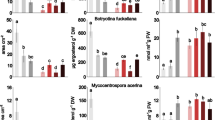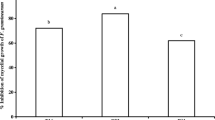Abstract
3-Acetyl deoxynivalenol (3-ADON) and esterase production were determined in a strain ofFusarium culmorum insensitive to the fungicide, difenoconazole. Following further exposure to this fungicide for different periods of time, the initiation of 3-ADON production was observed to be accelerated in the insensitive strain compared to a control (sensitive) strain of the phytopathogen. In particular, 3-ADON appeared in insensitive cultures within 21 days of incubation with fungicide levels of 1 to 4 µg/ml media and at 43 days with difenoconazole levels of 6 and 10 µg/ml. However, in the control strain, 3-ADON production was delayed until 28 and 57 days for the respective doses of fungicide. For these times and fungicide levels, the overall production of 3-ADON by the insensitive strain was significantly different from the zero values recorded with the control strain (P<0.05). Moreover, although difenoconazole was generally effective in depressing 3-ADON synthesis in both strains, the suppression was not significant (P>0.05) for the insensitive strain at 43 and 57 days of incubation with fungicide added at 1 µg/ml. In a parallel experiment, total esterase production was observed to increase progressively over time and at consistently higher levels for the insensitive strain from day 14 onwards so that by day 35 the strain difference was significant (P<0.05). Although the increase with time occurred in both strains, this enhancement appeared at 14 days in the insensitive strain (P<0.05) but delayed until 21 days in the control strain (P<0.05). In conclusion, these investigations have demonstrated the persistence of 3-ADON production and enhanced levels of total esterases in a strain ofF. culmorum insensitive to difenoconazole. Furthermore, it is proposed that changes in esterase profiles might be of diagnostic value in identifying toxigenic strains of differentFusarium species.
Similar content being viewed by others
References
Baayen RP, van Dreven F, Krijger, MC, Waalwijk C (1997) Genetic diversity inFusarium oxysporum f. sp.dianthi andFusarium redolens f. sp.dianthi. Europ J Plant Path 103: 395–408
Desjardins AE, Hohn TM, McCormick SP (1993) Trichothecene biosynthesis inFusarium species: chemistry, genetics, and significance. Microbiol Rev 57: 595- 604.
D’ Mello JPF, Macdonald AMC (1997) Fungal toxins as disease elicitore.In: Aspects of Environmental Toxicology. Edited by J Rose, pp. 255–291. Gordon and Breach Science Publishers, Yverdon, Switzerland
D’Mello JPF, Macdonald AMC, Cochrane MP (1993) A preliminary study of the potential for mycotoxin production in barley grain. Aspects Appl Biol 36: 375–382
D’Mello JPF, Porter JK, Macdonald AMC, Placinta CM (1997)Fusarium mycotoxins.In: Handbook of Plant and Fungal Toxicants. Edited by JPF D’Mello, pp. 287–301. CRC Press, Boca Raton, FL, USA
D’Mello JPF, Macdonald AMC, Bonte L (1997) The effects of difenoconazole on 3-acetyl eoxynivalenol synthesis byFusarium culmorum: implications for cereal quality.In: Crop Protection & Food Quality: Meeting Customer Needs, pp. 463–466. Proceedings of BCPC and ANPP Conference, Kent, UK
D’Mello JPF, Macdonald AMC, Postel D, Hunter EA (1998) 3-Acetyl deoxynivalenol production in a strain ofFusarium culmorum insensitive to the fungicide difenoconazole. Mycotoxin Res 13: 73–80
GareisM, CeynowaJ (1994) Influence of the fungicide Matador (tebuconazole/ triadimenol) on mycotoxin production byFusarium culmorum. Z LebensmUnters Forsch 198: 244–248
Hocart MJ, Lucas JA, Peberdy JF (1993) Parasexual recombination between W and R pathotypes ofPseudocercosporella herpotrichoides through protoplast fusion. Mycol Res 97: 977–983
Laemmli UK (1970) Cleavage of structural proteins during the assembly of the head of bacteriophage T4. Nature 227: 680–685
MeadR, Curnow RN (1983) Statistical Methods in Agriculture and Experimental Biology 335 pp. Chapman and Hall, London and New York
Milus EA, Parsons CE (1994) Evaluation of foliar fungicides for controllingFusarium head blight of wheat. Plant Dis 78: 697–699
Moss MO, Frank JM (1985) Influence of the fungicide tridemorph on T-2 toxin production byFusarium sporotrichioides. Trans Br Mycol Soc 84: 585–590
Placinta CM, Macdonald AMC, D’Mello JPF, Harling R (1996) The influence of carbendazim on mycotoxin production inFusarium sporotrichioides. In: Proceedings of The Brighton Crop Protection Conference pp 415–416, British Crop Protection Council, Farnham, UK
Snijders CHA, Perkowski J (1990) Effects of head blight caused byFusarium culmorum on toxin content and weight of wheat kernels. Phytopathol 80: 566–570
Wei R-D, Chu FS (1985) Modification of in vitro metabolism of T-2 toxin by esterase inhibitors. Appl Environ Microbiol 50: 115–119
Author information
Authors and Affiliations
Rights and permissions
About this article
Cite this article
D’Mello, J.P.F., Macdonald, A.M.C. & Dijksma, W.T.P. 3-Acetyl deoxynivalenol and esterase production in a fungicideinsensitive strain ofFusarium culmorum . Mycotox Res 14, 9–18 (1998). https://doi.org/10.1007/BF02945088
Received:
Accepted:
Issue Date:
DOI: https://doi.org/10.1007/BF02945088




